Alexandra Karamallis
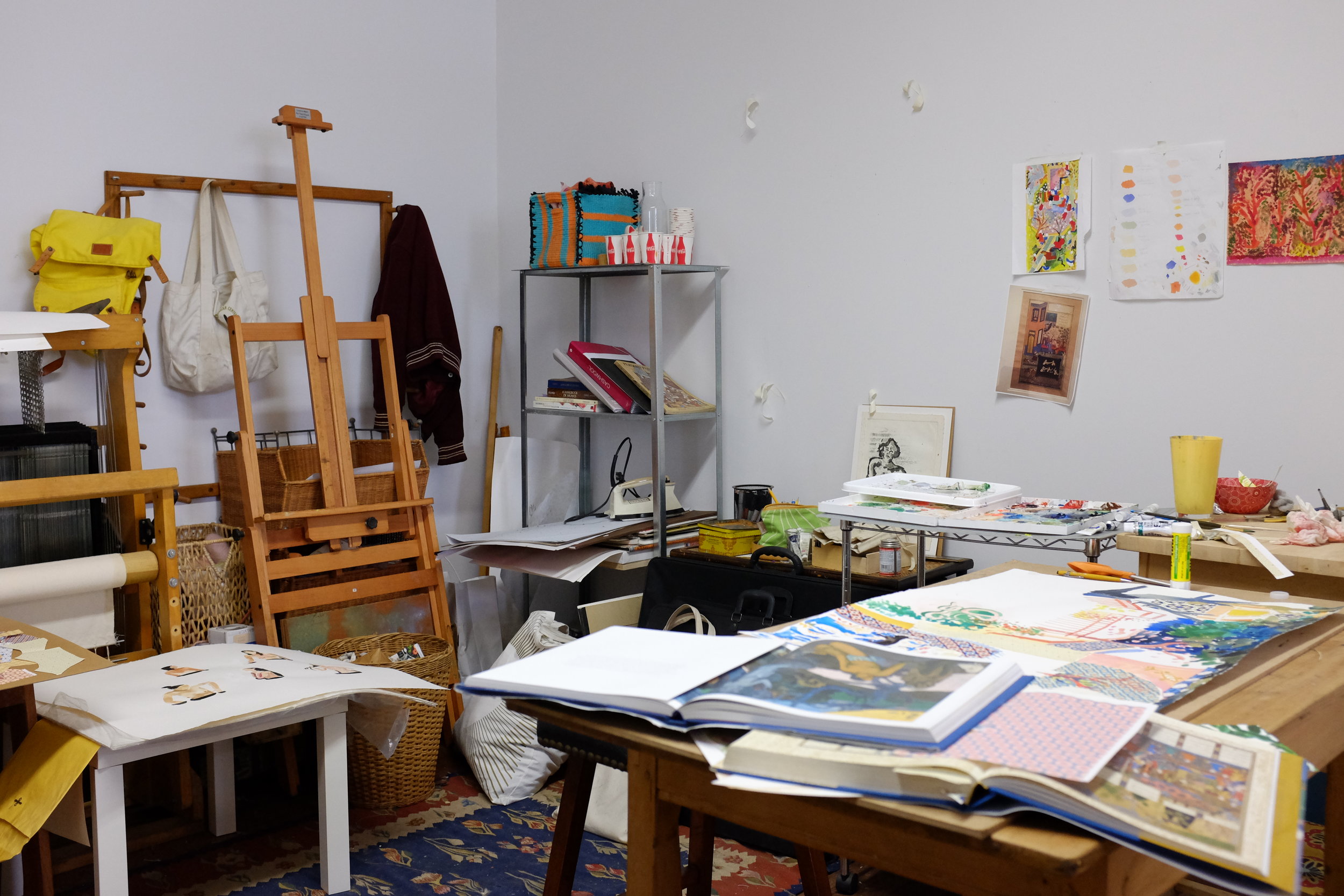
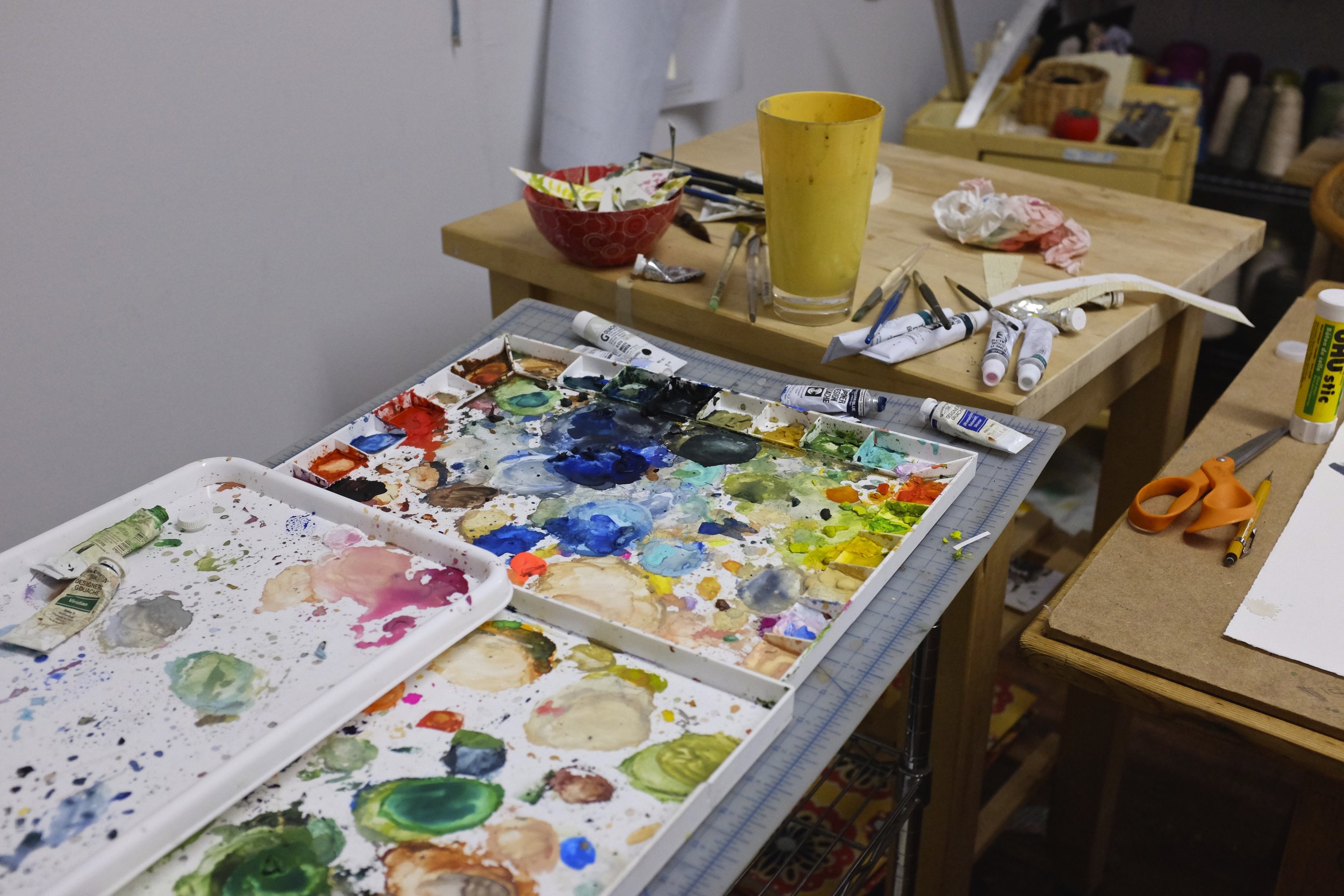
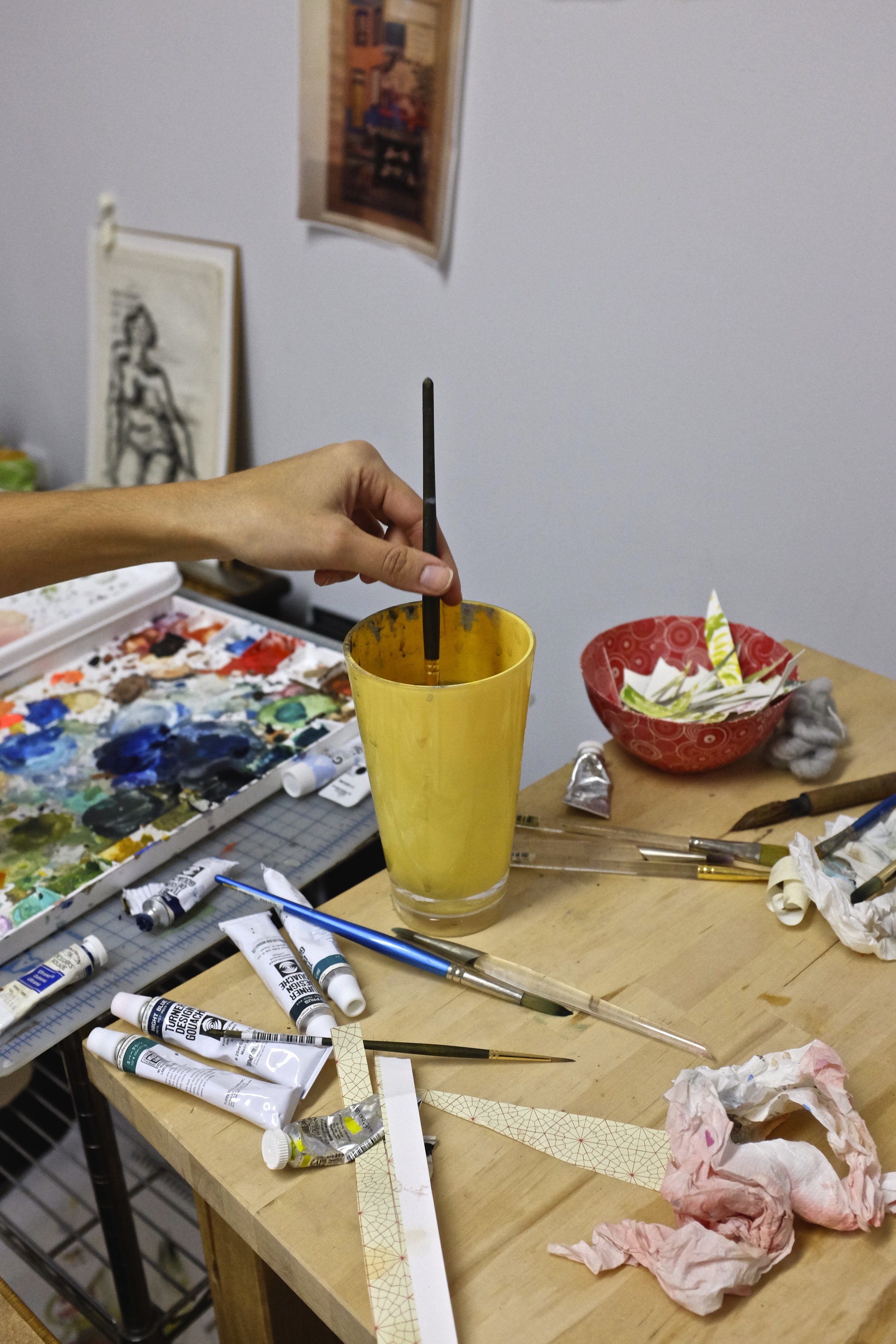
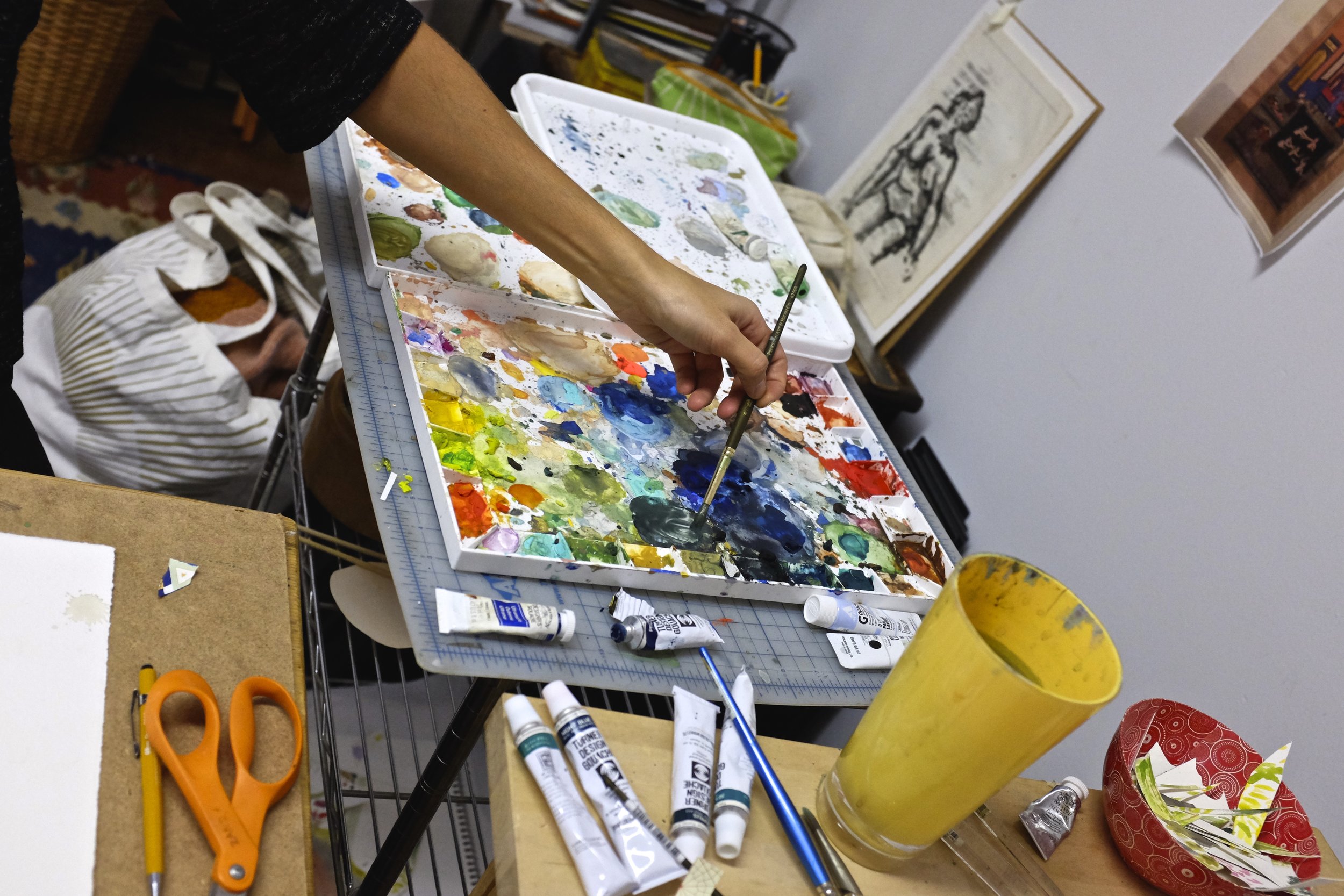
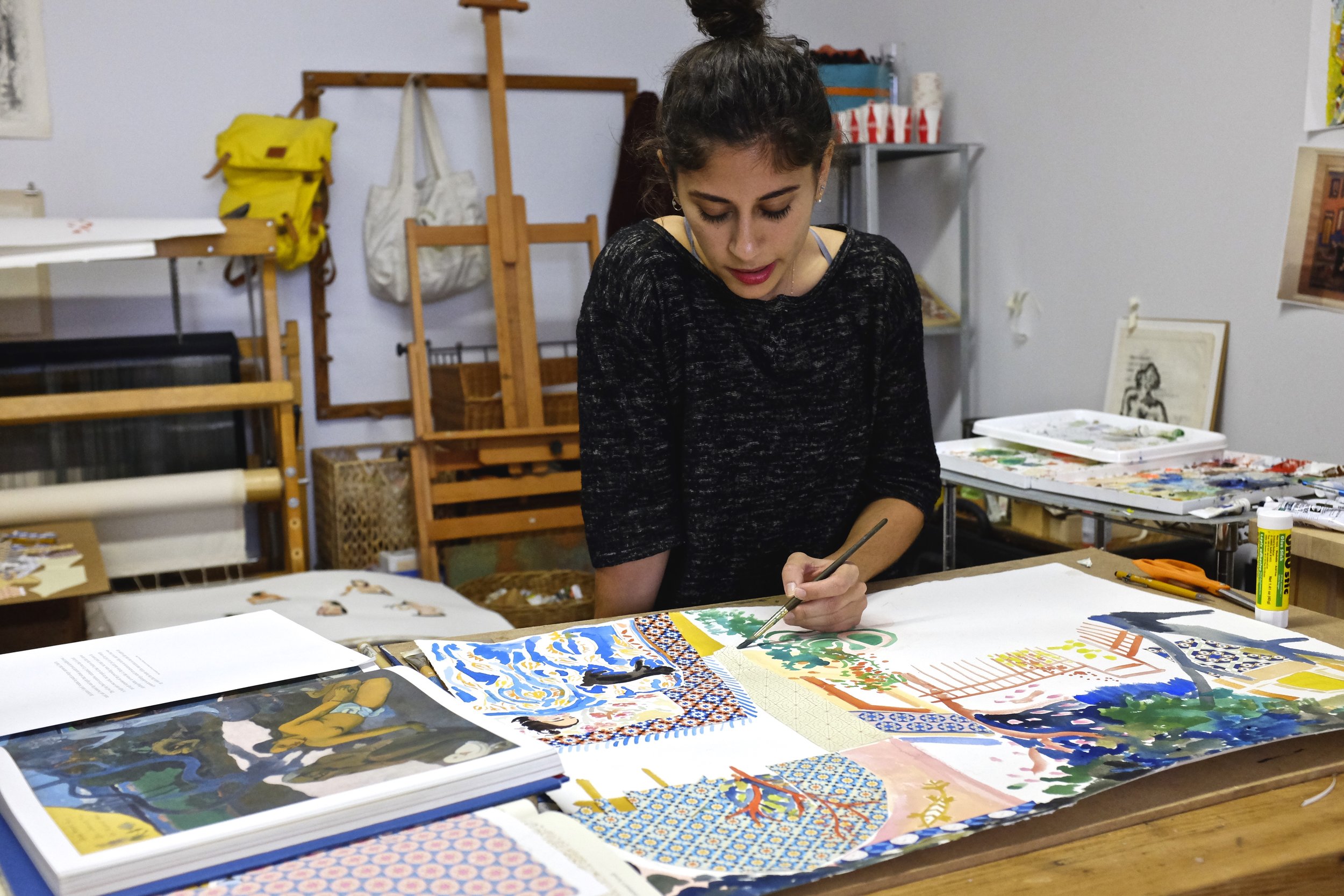
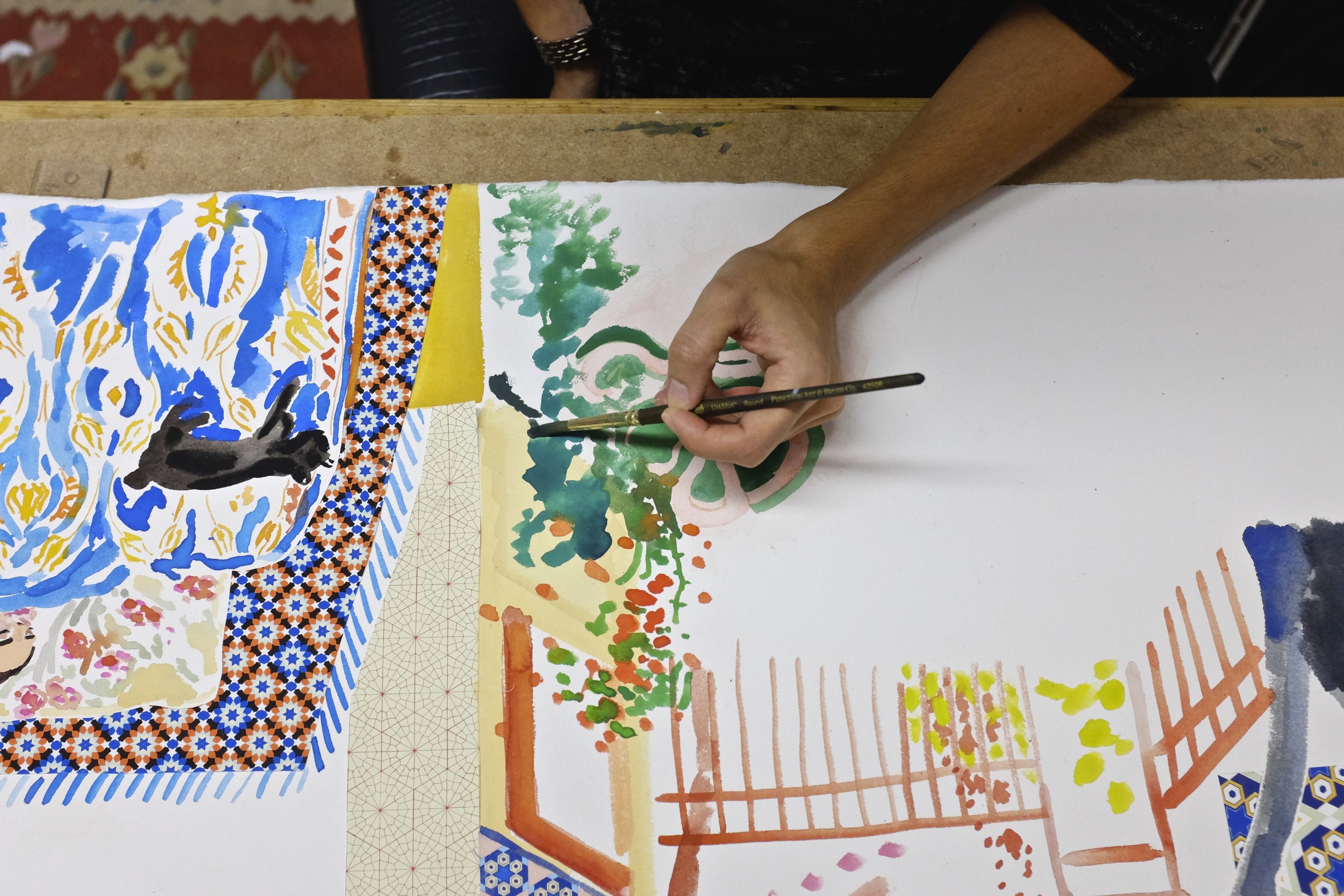
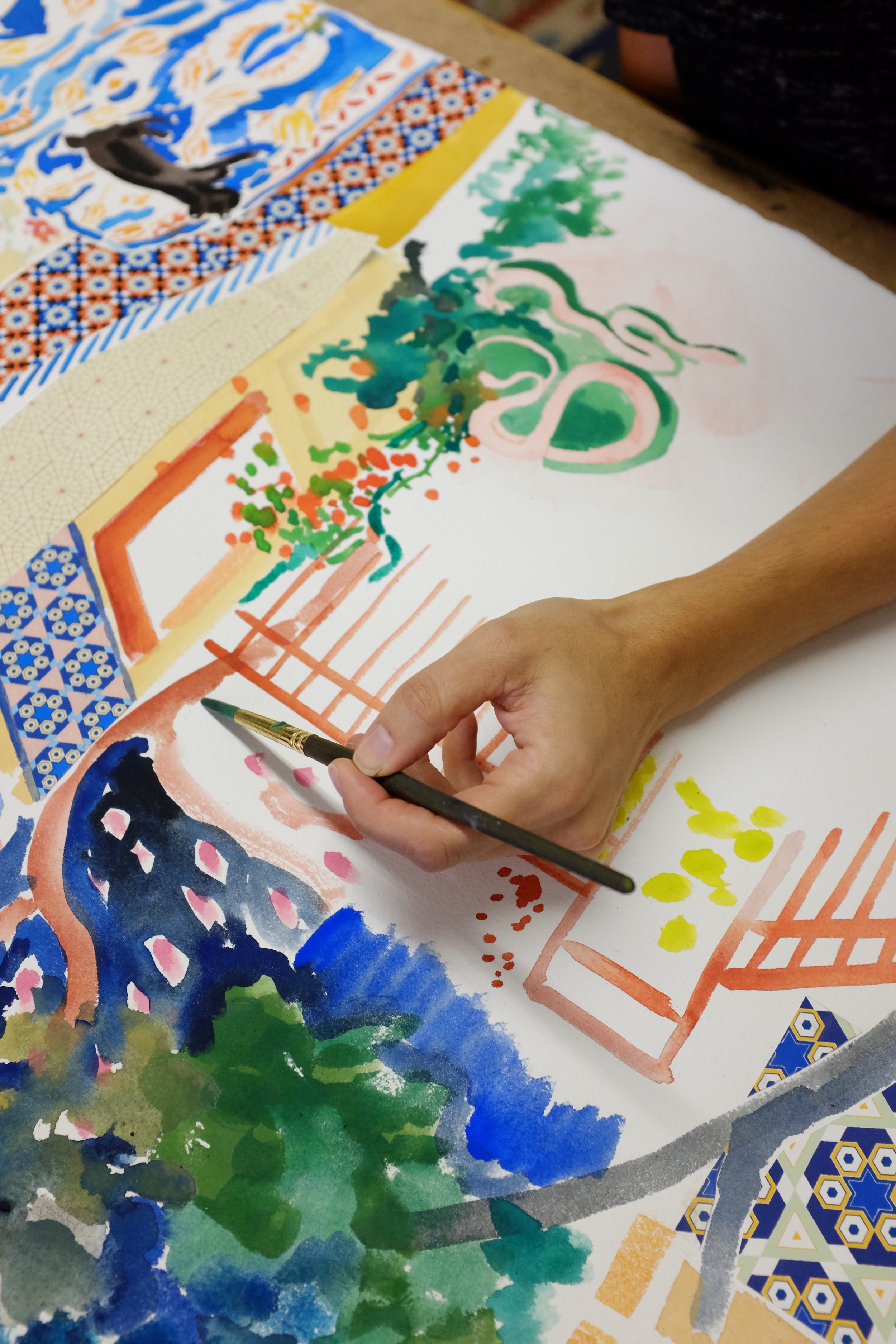
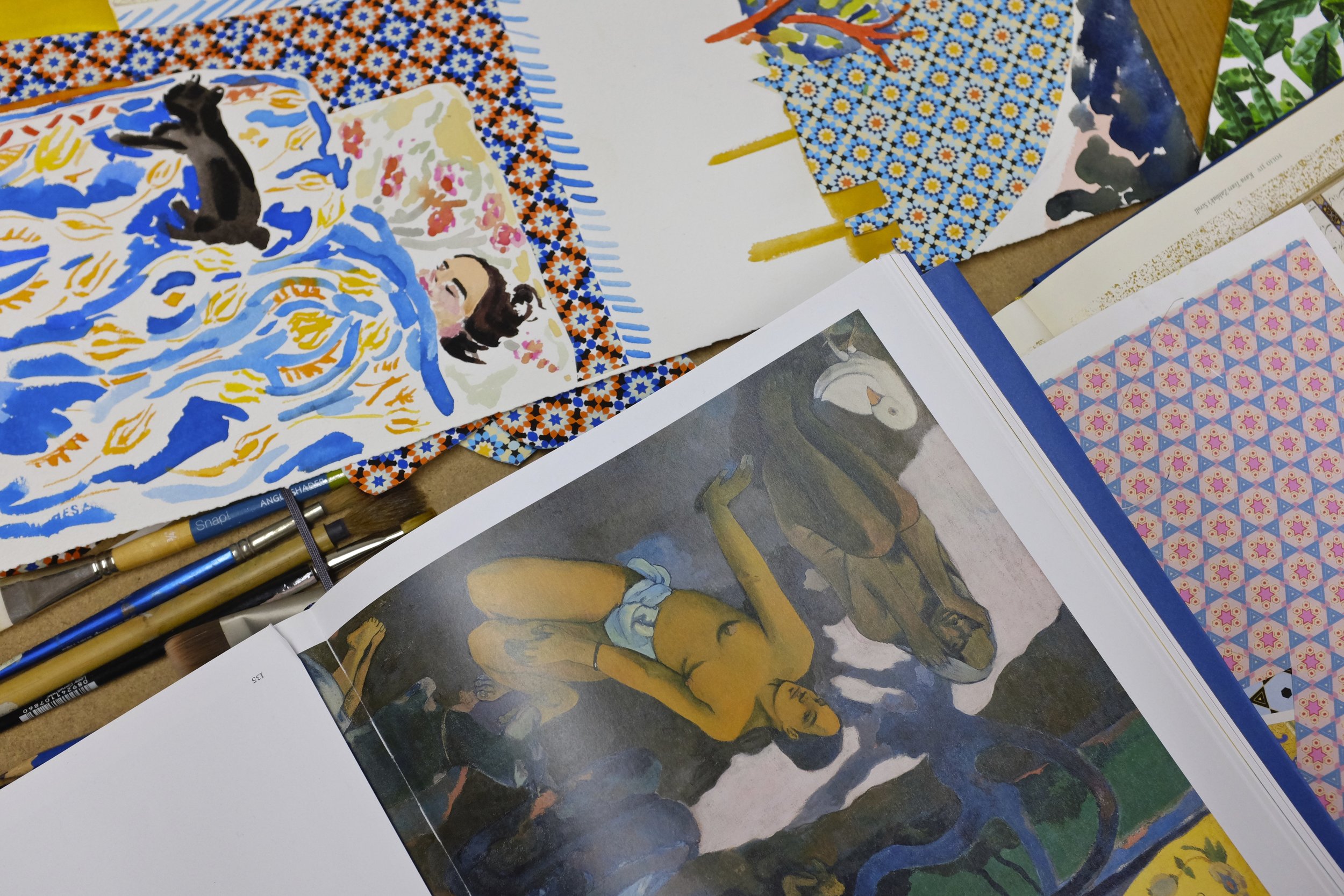
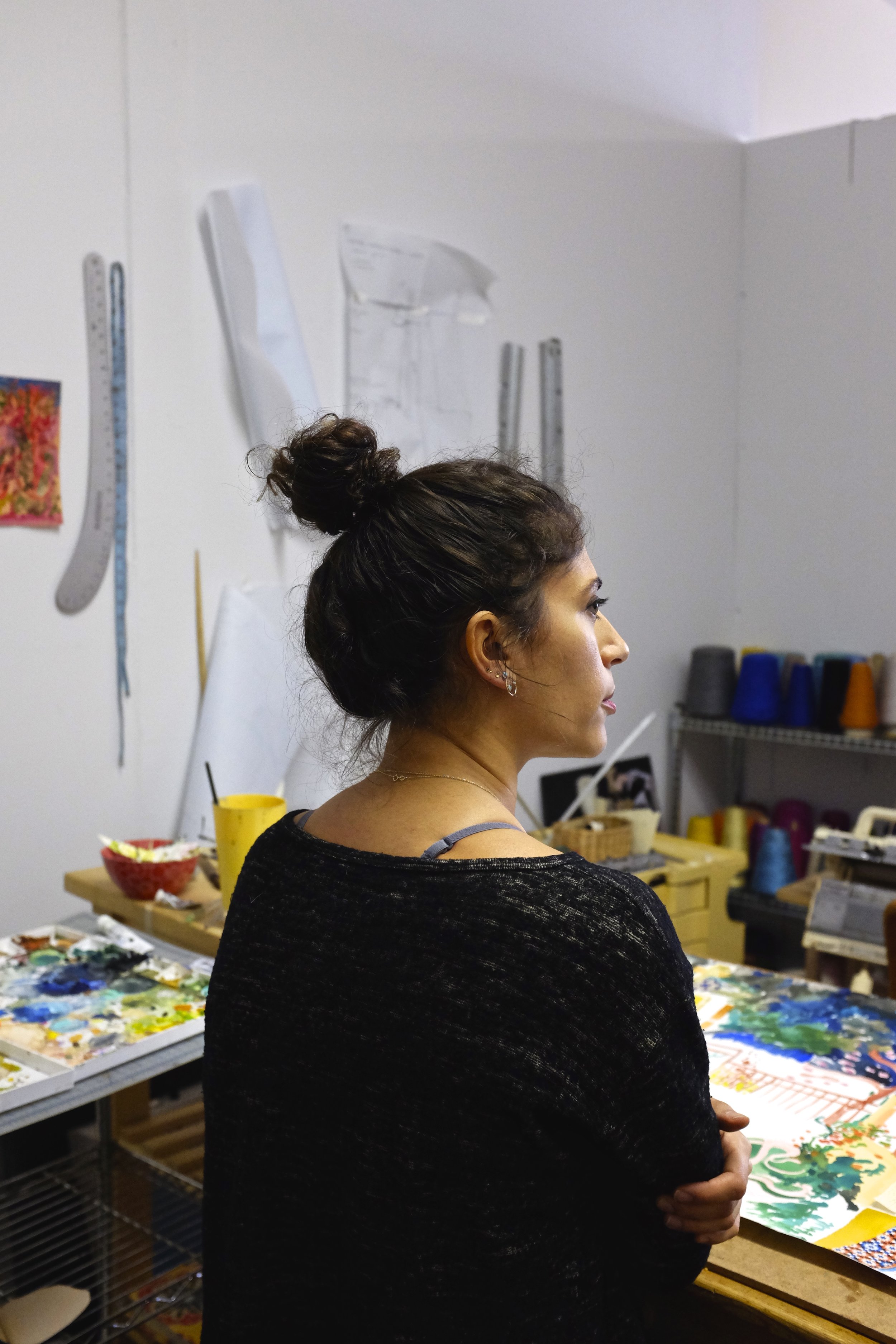

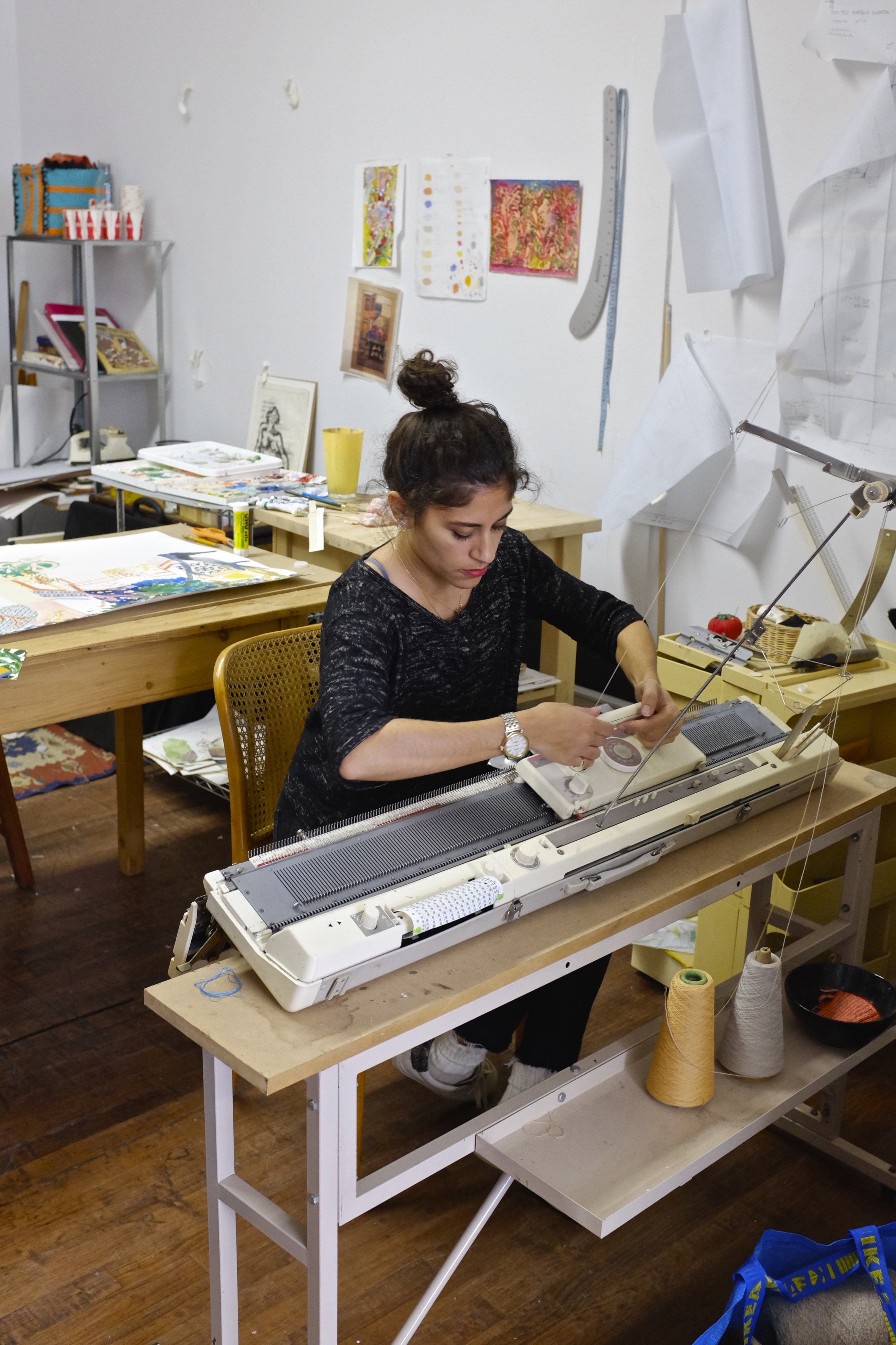


Alexandra Karamallis
Who are you?
I’m Alexandra Karamallis, I go by Zandy. I am a textile designer and an artist. I’ve lived here in Brooklyn for six years now. As my full time job I design accessories for Ralph Lauren, and then on the side I paint and collage and knit and do whatever else I feel inspired to do.
In terms of your personal work, what do you make?
At the moment, my personal work is watercolor gouache paintings/collages and sweaters. But it kind of varies. I’m a very whatever I feel inspired to do is what I will do kind of a creative person. I love knitting and painting, but I go through phases with both of them. I will really focus on painting for four or five months and then, often in the fall, I’ll start to feel like I want to knit a sweater.
Do you consider yourself an artist or a designer?
I have thought about it and I think that professionally I consider myself a designer, but my personal work goes more in the direction of art. I say that primarily because I feel a lot more inspired to create when I have a fully formed concept that is driving the process. I rarely paint without feeling really inspired by something that is conceptual or visual. Whereas when I make a sweater the inspiration comes more from my desire for that thing. Even if it is not for me, it is more about wanting an object than it is about the process of creating that object.
A couple of months ago I saw Toni Morrison speak live and the woman who was interviewing her asked her why she writes. She responded that her best thinking happens when she writes. That really stuck with me because I feel that way about the creative process at its best. When I am really inspired, I do my best thinking. I don’t really feel that way as much when I am designing as I do when I am making what I feel like is art.
Describe your workspace.
It is messy sometimes. I share my studio with three other people. I previously had my desk and knitting machine facing the wall because I wanted to be able to pin things on the wall to inspire me. That was nice but it felt a bit claustrophobic, so I recently re-arranged my things to face the window. The light and visibility to the outdoors has felt more inspiring.
I lot of my stuff in this space has been collected over the years; it is mostly filled with things that people have given me or that I have found. Each piece of furniture is from a different point and person in my life, so it feels like a collection of experiences. Aside from that, there is a loom, desk, knitting machine and a lot of yarn.
A lot of the work that on the walls is not mine. Two of the prints are my mom’s - she studied printmaking in college. There are two paintings that my grandfather did. He was Iranian and an architect and an incredibly talented, amazing person. He grew up in Tehran and left Iran when he was seventeen. He came to the United States and studied architecture at Berkeley. Before he died, he became sick with Alzheimer's. During his time of sickness it became more and more difficult for him to communicate, especially because his first language was Farsi - the Iranian language. He didn’t have a lot of people in his life at that time who spoke Farsi. But in the last five years of his life he started painting with acrylic on paper. I was at RISD at the time, and he and I were painting in a similar style without knowing it. That became a way for us to communicate without the ability to really have conversations. I would show him what I was working on and he would show me his paintings. I don’t know if this is true or if I made it up in my head, but at some point he expressed to somebody that a lot of what his paintings were inspired by was his memories of Iran. That was very touching to me, so I have a couple of his paintings up on the wall. I draw inspiration from them and sometimes reference them in my paintings. In a way it is the closest I have ever come to being there.
Describe your process.
It varies from piece to piece. Typically in the front end of the process I do the research and take notes, then I come to a decision more or less about what I want the content of the painting to be. Then I do visual research. I usually have multiple books and I try to learn from them. I have a book of Persian miniature paintings, I have books of the artists that I love who depict women really beautifully and use color in a way that really speaks to me. I try not to copy anything, but I also try to learn from how these artists depict scenes that feel sensual and respectful of women. Then I sit down and paint. I try to come up with a color story that feels cohesive. Often times if I decide on a color that I want to have some kind of movement throughout the piece, I will lay it down in a couple places instead of finishing one area first. I try to look at the whole thing throughout the process. I think that a lot of painters do that to create a larger, cohesive composition.
I don’t like to throw out any of my art, even if it is bad. In one of the last paintings I did, I really didn’t like an area; it was getting muddier and muddier the more I tried to fix it. So I ended up cutting up old paintings that I didn’t like and collaging them in to get the white of the paper back. It’s not that big of an idea, but it opened up a new part of my process. I’ve been painting random shapes, patterns or textures onto other paper and then cutting them up and collaging them in. It is really fun and a very liberating feeling to work that way. Anything goes - you can’t really make a major mistake. You can paint whatever you want and if you don’t like it you can collage over it.
What role does your heritage play in your work?
I am of Iranian background. I am only a quarter Iranian but I have always been very inspired by that part of my heritage, both because Persian art and architecture are so visually stunning and because in my lifetime there has been such turmoil in Iran that has prevented me from ever going there. The level of oppression towards people there is heart wrenching to me and has certainly held my attention.
A lot of my work deals specifically with oppression of females in Iran and in the Middle East in general, as well as the oppression of art, architecture and textile traditions over the years. Prior to the revolution, which took place in 1979, Iran was a very modern country. There was a lot of western influence; they considered it the Paris of the Middle East. Now women are forced to wear headscarves and black. But there are stories of women still wearing sick outfits under their burkas. There is a book called Reading Lolita in Tehran; it’s a true story about a woman who taught English in Iran in the nineties at the University of Tehran. During her career, the university got stricter and stricter in terms of what novels she was allowed to have her class read, eventually to the point that she quit her job because she felt so controlled and stifled by it. She started this study group in her house where women read Western novels that were forbidden by law. I read this book in college and was really inspired by one of the first scenes where all of the women arrive at her house for the first meeting and take off their black, drab clothing to reveal their really amazing outfits underneath. I am really inspired by this idea of dressing beautifully and in bright colors as a way to be expressive even if you have to cover up. I really like the idea that it is just for yourself, not to impress a man or to impress the outside world. It’s a tradition or ritual that you feel is important.
So my work is very much centered around this idea of celebrating femininity and Middle Eastern heritage or background. I don’t want to speak for other cultures, but I think that a lot of the people who have left Middle Eastern countries - Iran specifically - have a tendency to feel a lot of shame given their heritage. It has been important for me as a woman of that culture to feel connected to my heritage, celebratory and proud of it.
What are some of your other sources of inspiration?
Just recently I got invited to participate in this show in South Africa that was celebrating a lot of the things that I just described. It was called Sewing Paradise. It was centered around Suzani fabrics, which are these really amazing embroidered fabrics that come from Uzbekistan. Uzbekistan was part of the Persian Empire originally so it’s in the same region as Iran. The fabrics are traditionally hand embroidered by women as a part of their dowry. The technique is considered to be a secret language that is passed down from one generation of women to the next, a tradition since Zoroastrian times. There are all sorts of motifs and symbols in the fabric that represent femininity, fertility and protection against evil. That show kind inspired a new direction and area of work for me to look at. Also Persian miniature painting, and Persian rugs and gardens. One of the biggest goals in a Persian garden is to create protected relaxation outdoors with the same level of privacy that you would feel in your own home. That is something that is really interesting to me.
I also love Matisse, Willem de Kooning and Gauguin. For me Gauguin is really inspiring because he depicts women outside in gardens of paradise. Even though they’re in Tahiti, they are similar to the imagined space that I have in my mind. Often in my work I like to re-imagine my idealized version of an existing problematic scenario. I know that the world is complex and problematic and that people do things with bad intentions. Even though Gauguin objectified women and exploited a culture, he created beautiful work that I find visually inspiring. So I take that from it and leave the rest.
How do these inspirations manifest in your work formally?
In many ways - in terms of color choices and content. It started with my paintings for my thesis project at RISD, which were more abstract. The process began with looking at Persian miniature paintings for composition and color, and then abstracting them. The idea there was to take a very rigid art form and make it abstract expressionist, like the way that rigidity creates chaos in the Middle East. Since then I have gotten a bit more illustrative, mostly for the sake of depicting women. I’ve started painting women in a clear way. I also use those symbols from Suzani fabrics, like pomegranates, tulips, carnations and chrysanthemum trees. I have felt more inclined to depict those things more clearly for symbolic reasons. Also, the papers that I collage with utilize traditional Middle Eastern tile patterns.
Does your work tell any stories?
Each painting has a different story to it. There was one painting I did for the Sewing Paradise show that has women bathing in a pool. I saw a Persian miniature painting at The Met of women bathing at night in a Persian garden. I forget what it is called, but it’s something like “The Voyeur.” You can see men in the background creeping on the women - it is really interesting that in the 1400s that was a subject for a Persian miniature painting. You can’t really tell that the women are women except for the fact that they have long hair. Even then it was very taboo to paint breasts. So with my painting, the idea was to make a Persian garden a safe space for protected relaxation. It should be able to exist for women, since it is only ever depicted for men. And the women have the right to be expressive of the fact that they are women; my women have breasts and look feminine. I think that it’s more sensual looking than that Persian miniature painting in particular. Each painting has a specific idea behind it, but always within this larger theme.
How have you learned what you know?
While I was at RISD, I learned a lot of skills and how to think conceptually. I learned how to think critically and speak about my work and criticize other people’s work, which ultimately made me a harsher critic on myself. I always felt like I didn’t do the level of research there that I wish I had done, but truly I don’t think that there was time or space for it. Since school I’ve done a lot of independent research. I have bought a lot of books, done a lot of research online and spoken to family members with Iranian heritage. I try as best I can to have a variety of sources that inform my work.
What’s the best piece of advice you’ve ever received?
Wow. I don’t know if I have ever gotten good advice. More and more - this is so clichéd and obvious - I try to focus my energy to do what I love and to do what makes me happy. Maybe this is more personal, but I struggle with the collage-ness of my life, which can feel scattered and overcommitted to a lot of different things. I don’t like to disappoint and I like to accommodate everything and everyone. It’s been really important for me to determine what the things are that I really like to do versus the things that I feel obligated to do or are good for me to do. I’ll ask myself, What makes me happy? What do I love? What do I enjoy? Then I really prioritize those things and put my energy into them. I love to do my art and I am the only person who can hold myself accountable for it. It’s up to me to do it. With something like coming to my studio and painting, nobody will know if I don’t come. I really have to be responsible and accountable for myself and know what it is that makes me happy and prioritize that.
How has your practice shaped your hands?
I have a bump on my finger from drawing. I know that when I’m in the midst of painting or creating or dying fabrics, I completely neglect all safe practices. I have slit open my thumb from cutting things and I have used lots of chemicals directly on my hands that I am not supposed to. I have a tendency to allow the process to abuse my hands a little bit. I’m sure that I have a few more wrinkles or scars on my hands than I would if the process didn’t have that effect on me. They are probably not as pretty as they could be if I did something else, but that’s okay with me.
Alexandra Karamallis in Brooklyn, New York on October 22, 2017. Photographs by Julia Girardoni.
